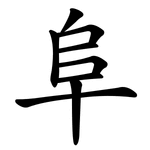

| 阜 | ||||
|---|---|---|---|---|
| ||||
| 阜 (U+961C) "mound, dam" | ||||
| Pronunciations | ||||
| Pinyin: | fù | |||
| Bopomofo: | ㄈㄨˋ | |||
| Wade–Giles: | fu4 | |||
| Cantonese Yale: | fau6 | |||
| Jyutping: | fau6 | |||
| Japanese Kana: | フ fu / フウ fū (on'yomi) おか oka (kun'yomi) | |||
| Sino-Korean: | 부bu | |||
| Hán-Việt: | phụ | |||
| Names | ||||
| Chinese name(s): | (⻖) 左耳旁 zuǒ'ěrpáng | |||
| Japanese name(s): | こざとへん kozatohen 岐阜の阜 Gifu no fu | |||
| Hangul: | 언덕 eondeok | |||
| Stroke order animation | ||||
 | ||||

Radical 170orradical mound (阜部) meaning "mound"or"dam" is one of the 9 Kangxi radicals (214 radicals in total) composed of 8 strokes. This radical character transforms into 阝 (counted as 3 strokes in Traditional Chinese, 2 strokes in Simplified Chinese) when used as a left component (Not to be confused with 阝 on the right derived from 邑).
In the Kangxi Dictionary, there are 348 characters (out of 49,030) to be found under this radical.
阜 is also the 175th indexing component in the Table of Indexing Chinese Character Components predominantly adopted by Simplified Chinese dictionaries published in mainland China, with 阝 (left) listed as its associated indexing component.
| Strokes | Characters |
|---|---|
| +0 | 阜 阝 |
| +2 | 阞 队SC (=隊) |
| +3 | 阠 阡 阢 阣 阤 |
| +4 | 阥 (=陰) 阦 (=陽) 阧 阨 (=厄 -> 厂) 阩 阪 阫 阬 阭 阮 阯 (=址 -> 土) 阰 阱 防 阳SC (=陽) 阴SC (=陰) 阵SC (=陣) 阶SC (=階) |
| +5 | 阷 阸 阹 阺 阻 阼 阽 阾 (=嶺 -> 山 鄰 -> 邑) 阿 陀 陁 陂 陃 附 际SC (=際) 陆SC (=陸) 陇SC (=隴) 陈SC (=陳) 陉SC (=陘) |
| +6 | 陊 陋 陌 降 陎 陏 限 陑 陒 陓 陔 陕SC (=陝) |
| +7 | 陖 陗 (=峭 -> 山) 陘 陙 陛 陜 (=狹 -> 犬 / 峽 -> 山) 陝 陞 (=升 -> 十) 陟 陠 陡 院 陣 除 陥JP (=陷) 陦SC (=隯) 陧SC (=隉) 陨SC (=隕) 险SC (=險) |
| +8 | 陚 陪 陫 陬 陭 陮 陯 陰 陱 陲 陳 陴 陵 陶 陷 陸 陹 険JP (=險) |
| +9 | 陻 (=堙 -> 土) 陼 陽 陾 陿 (=狹 -> 犬) 隀 隁 隂 (=陰) 隃 隄 (=堤 -> 土) 隅 隆 隇 隈 隉 隊 隋 隌 隍 階 随SC/JP (=隨) 隐SC (=隱) |
| +10 | 隑 隒 隓 隔 隕 隖 (=塢 -> 土) 隗 隘 隙 |
| +11 | 隚 際 障 隝 (=島 -> 山) 隞 隟 (=隙) 隠JP (=隱) 隡 |
| +12 | 隢 隣 (=鄰 -> 邑) 隤 隥 |
| +13 | 隦 隧 隨 隩 險 隫 |
| +14 | 隬 隭 隮 隯 隰 隱 隲 (=騭 -> 馬) |
| +15 | 隳 |
| +16 | 隴 |
| +17 | 隵 |
This kanji is one of the 20 kanji added to the Kyoiku kanji or kanji taught in Japanese elementary schools that are found in the names of the following prefectures of Japan.[1] It was added because it is the second character in Gifu (岐阜県).[1]
|
Chinese radicals according to the Kangxi Dictionary
| |
|---|---|
| 1 stroke |
|
| 2 strokes |
|
| 3 strokes |
|
| 4 strokes |
|
| 5 strokes |
|
| 6 strokes |
|
| 7 strokes |
|
| 8 strokes |
|
| 9 strokes |
|
| 10 strokes |
|
| 11 strokes |
|
| 12 strokes |
|
| 13 strokes |
|
| 14 strokes |
|
| 15 strokes |
|
| 16 strokes |
|
| 17 strokes |
|
See also: Kangxi radicals | |
|
Simplified Chinese characters radicals (indexing components)
| |
|---|---|
| 1 stroke |
|
| 2 strokes |
|
| 3 strokes |
|
| 4 strokes |
|
| 5 strokes |
|
| 6 strokes |
|
| 7 strokes |
|
| 8 strokes |
|
| 9 strokes |
|
| 10 strokes |
|
| 11 strokes |
|
| 12 strokes |
|
| 13 strokes |
|
| 14 strokes |
|
| 17 strokes |
|
GF 0011-2009 Table of Indexing Chinese Character Components prescribes 201 principle indexing components and 100 associated indexing components (in brackets) used in Simplified Chinese. Not all associated indexing components are listed above. | |